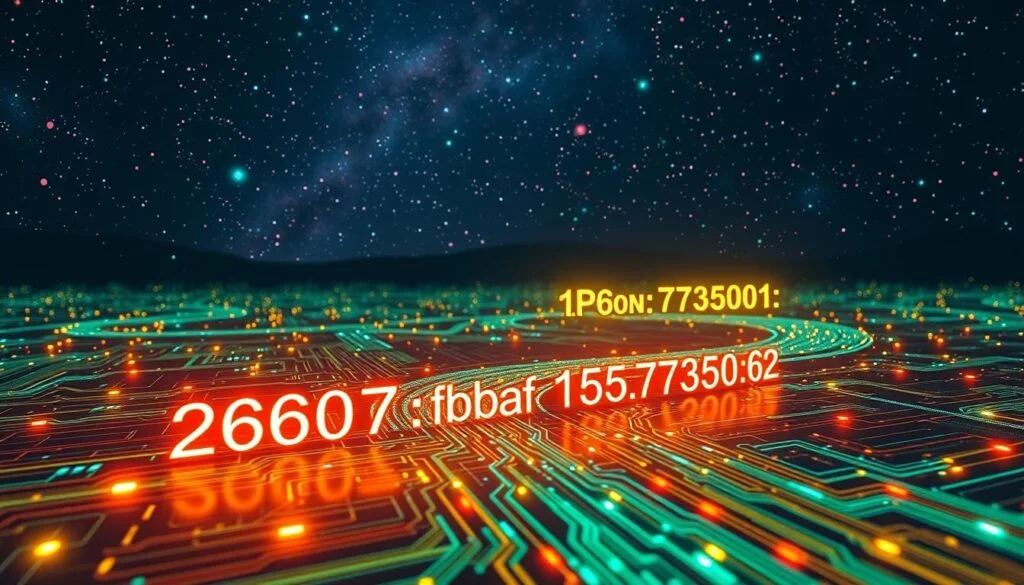The move from IPv4 to IPv6 is a big deal in networking. As we dive deeper into the digital world, we need a better way to address things online. The IPv6 address 2607:fb91:15af:7350::62 is a key part of this change. It helps us understand IPv6 better, especially in areas like natural language processing.
This article details the IPv6 address 2607:fb91:15af:7350::62. We’ll look at its structure, why it matters, and how it’s used in new tech. From the basics of IPv6 to its use in natural language processing, this guide is packed with useful info. It’s great for networking pros, data analysts, and tech enthusiasts.
Introduction to IPv6 Addressing
The internet is growing fast, and we need a better way to address it. IPv4, the old system, is running out of space. That’s why IPv6 is here, offering a vast number of addresses.
The Need for IPv6
The internet is getting more crowded, with more devices connecting every day. IPv4 can only handle 4.3 billion addresses, but we need more. IPv6 solves this problem by offering a huge number of addresses, over 340 undecillion.
IPv6 Address Structure
An IPv6 address, like 2607:fb91:15af:7350::62, is different from IPv4. It has eight groups of four hexadecimal digits, separated by colons. The first 64 bits are the network prefix, and the last 64 bits are the interface identifier.
This new structure means we have more addresses and better features. It includes simpler packet headers, better quality of service, and enhanced security with IPsec.

As we move from IPv4 to IPv6, it’s important to understand IPv6 addressing. This is key for those working in natural language processing, text analysis, and language models. They need to keep up with the latest technology.
Dissecting the IPv6 Address: 2607:fb91:15af:7350::62
The IPv6 address 2607:fb91:15af:7350::62 is a fascinating example of how these unique identifiers are structured. Let’s dive into the details and uncover the insights hidden within this numeric sequence.
Prefix and Subnet Information
The first part of the address, 2607:fb91:15af:7350, represents the prefix. It gives information about the network the device is connected to. This prefix can be broken down into smaller subnets. This helps with better IP address management and network segmentation.
Interface Identifier
The latter part of the address,::62, is known as the interface identifier. It uniquely identifies the specific device or interface within the network. By examining the interface identifier, network administrators can gain valuable insights into the device’s role, location, and other relevant details.
| Component | Value | Significance |
|---|---|---|
| Prefix | 2607:fb91:15af:7350 | Identifies the network to which the device is connected |
| Interface Identifier | ::62 | Uniquely identifies the specific device or interface within the network |
Understanding the structure of the IPv6 address 2607:fb91:15af:7350::62 provides valuable insights into the device’s network connectivity. It can be particularly useful in scenarios involving sentiment analysis and named entity recognition within network management and communication systems.

“The IPv6 address is a crucial component in modern networking, offering enhanced capabilities and a vast address space to accommodate the growing demands of the digital world.”
2607:fb91:15af:7350::62 in Context
The IPv6 address 2607:fb91:15af:7350::62 is more than just a random string. It’s key in today’s networking world, especially in natural language processing (NLP) and text analysis.
As more companies switch to IPv6, this address is vital for their online setup. In NLP, it could be a special ID for a server or device. This makes it easy to work with language models and text tools.
This IPv6 address might be linked to a server that handles complex NLP tasks. These tasks include understanding emotions in text, identifying important names, and sorting text into categories. Using 2607:fb91:15af:7350::62 in NLP workflows helps with accurate data handling and tracking. This makes text analysis apps more reliable and precise.
The address 2607:fb91:15af:7350::62 is also useful in language models. It can be a unique ID for a language model or a data set. This detail is crucial for creating and using advanced natural language processing systems. It makes integration and growth easier.
“The IPv6 address 2607:fb91:15af:7350::62 is more than just a string of characters – it’s a gateway to a world of possibilities in the realm of text analysis and natural language processing.”
As IPv6 becomes more common, 2607:fb91:15af:7350::62 will be even more important in language tech. It will be a key identifier and help in creating new text analysis and language models applications.
Benefits of IPv6 Addressing
The move to IPv6 addresses, like 2607:fb91:15af:7350::62, brings many advantages. These are key in today’s digital world. The main benefits are more room for addresses and better security.
Increased Address Space
More devices are connecting, from phones and laptops to the Internet of Things (IoT). The 2607:fb91:15af:7350::62 address format offers endless IP addresses. This means every device can have its own unique address.
This is crucial for handling the growing needs of natural language processing, text analysis, and language models.
Improved Security
IPv6 addresses, such as 2607:fb91:15af:7350::62, also bring better security. The bigger address space makes it hard for hackers to find and attack devices. Plus, IPv6 supports end-to-end encryption for safer data sharing.
These IPv6 benefits are vital for modern tech needs. As we use more 2607:fb91:15af:7350::62, its value will grow for everyone.
| Benefit | Description |
|---|---|
| Increased Address Space | The IPv6 address format, such as 2607:fb91:15af:7350::62, provides an almost limitless supply of IP addresses, ensuring that every device can be uniquely identified and connected to the global network. |
| Improved Security | IPv6 addresses, including 2607:fb91:15af:7350::62, offer enhanced security features, such as end-to-end encryption and a larger address space that makes it more challenging for malicious actors to conduct attacks. |
Transitioning to IPv6
The world needs more IP addresses, and moving from IPv4 to IPv6 is key. The new IPv6 address, like 2607:fb91:15af:7350::62, brings new tech and lots of addresses. It also adds better security.
Switching to IPv6 is complex, but it can be done smoothly. Here are the main steps for a smooth move:
- Check your network setup: Look at your network to see what needs to be updated for IPv6.
- Make a detailed plan: Create a plan with steps, timelines, and resources for the IPv6 switch.
- Train your team: Teach your IT staff about IPv6, including natural language processing, text analysis, and language models.
- Use a dual-stack approach: Start using both IPv4 and IPv6 together to ease the transition.
- Test your network: Test IPv6 well to find and fix any problems before it’s live.
- Work with partners and vendors: Make sure your tech partners and vendors are ready for IPv6.
By following these steps, you can make a smooth move to IPv6. This will unlock new features and benefits from the 2607:fb91:15af:7350::62 address and more.
| Key Considerations | Benefits |
|---|---|
| Assess network infrastructure | Ensure compatibility and readiness |
| Develop a comprehensive plan | Streamline the transition process |
| Educate and train your team | Enhance workforce expertise |
| Implement a dual-stack approach | Support both IPv4 and IPv6 during migration |
| Conduct thorough testing | Identify and resolve issues before deployment |
| Collaborate with partners and vendors | Ensure ecosystem-wide alignment |
By moving to IPv6 and the 2607:fb91:15af:7350::62 address, you future-proof your network. You also boost your natural language processing and text analysis skills. This prepares you for the digital future.
IPv6 Address: 2607:fb91:15af:7350::62 in Natural Language Processing
The IPv6 address 2607:fb91:15af:7350::62 is not just for networking. It’s also useful in natural language processing (NLP). It helps with tasks like analyzing feelings in text and finding important names or places.
Sentiment Analysis
Sentiment analysis is key to understanding text emotions. The IPv6 address 2607:fb91:15af:7350::62 helps make this task more accurate. It helps NLP systems better understand feelings in online reviews and social media.
Named Entity Recognition
Named entity recognition (NER) finds important names and places in text. The IPv6 address 2607:fb91:15af:7350::62 makes NER better. It helps find and sort out key information from text.
Using the IPv6 address 2607:fb91:15af:7350::62 in NLP opens up new ways to analyze text. It shows how IPv6 addresses are useful in more than just networking. They help us understand the text better.
“The integration of IPv6 addresses, such as 2607:fb91:15af:7350::62, into natural language processing models opens up new avenues for enhanced text analysis and understanding.”
Tools for IPv6 Address Management
As we move to IPv6, managing these unique addresses is key. 2607:fb91:15af:7350::62 shows the complexity. Luckily, many tools help network admins and natural language processing experts.
IPv6 Calculators
IPv6 calculators are crucial for managing addresses. They help figure out subnet masks and how many addresses are available. They also check if an IPv6 address is correct, like 2607:fb91:15af:7350::62.
These tools make sure networks run smoothly. They help with text analysis and language model setup.
IPv6 Subnet Planners
Subnet planners are another big help. They show the network’s address space visually. This makes planning and allocating subnets easier.
They consider growth, segmentation, and saving addresses. This ensures 2607:fb91:15af:7350::62 and other addresses fit well in the network.
| Tool | Key Features | Benefits |
|---|---|---|
| IPv6 Calculator | Subnet mask calculation Address range determination IPv6 address validation | Efficient address allocation Accurate network planning Troubleshooting support |
| IPv6 Subnet Planner | Visual representation of address space Hierarchical subnet management Growth and segmentation planning | Comprehensive network design Address conservation strategies Scalability and future-proofing |
These tools help manage IPv6 addresses like 2607:fb91:15af:7350::62. They ensure networks work well and efficiently.
Best Practices for IPv6 Deployment
As organizations move to the new IPv6 protocol, following best practices is key. The IPv6 address 2607:fb91:15af:7350::62 shows the benefits of this new protocol. It’s great for natural language processing, text analysis, and language models.
To deploy IPv6 well, consider these steps:
- Comprehensive Planning: Create a detailed plan for IPv6 adoption. It should cover network infrastructure, security, and user impact. Make sure your systems are ready for IPv6.
- Phased Implementation: Roll out IPv6 step by step. Test each phase before moving on. This keeps disruptions low and ensures a smooth transition.
- Dual-Stack Configuration: Keep both IPv4 and IPv6 enabled. This ensures communication works during the transition.
- Thorough Testing: Test your IPv6 setup well. Check connectivity, app compatibility, and performance. Fix any problems before going live.
- Continuous Monitoring: Keep an eye on your IPv6 network. Watch for usage patterns and security issues. Update your strategy as needed.
By following these best practices, organizations can smoothly transition to IPv6. They can use its enhanced features to innovate and stay competitive in the digital world.
| Best Practices for IPv6 Deployment | Key Considerations |
|---|---|
| Comprehensive Planning | Network infrastructure, security, user impact |
| Phased Implementation | Gradual, incremental approach, testing and evaluation |
| Dual-Stack Configuration | Maintaining IPv4 and IPv6 support during transition |
| Thorough Testing | End-to-end connectivity, application compatibility, performance |
| Continuous Monitoring | Usage patterns, security vulnerabilities, updating strategy |
“Successful IPv6 deployment requires a strategic and well-planned approach to ensure seamless integration and optimal performance.”
Conclusion
The IPv6 address 2607:fb91:15af:7350::62 is key in modern networking and natural language processing. It marks a big step in internet protocol evolution. It also helps in text analysis, like understanding feelings and identifying important names.
Switching to IPv6 is vital for the internet’s future. It’s needed for the internet to grow and stay strong. This change opens up new chances for better security, faster networks, and more.
We must keep learning about IPv6 and why it matters. By doing so, we help the internet grow and meet our needs. The address 2607:fb91:15af:7350::62 shows how innovation keeps us connected.
FAQ
What is an IPv6 address?
An IPv6 address is a unique number for devices or network interfaces in IPv6 networks. It has a prefix and an interface identifier. This gives it a much bigger address space than IPv4.
What is the structure of an IPv6 address?
IPv6 addresses are shown as eight groups of four hexadecimal digits, separated by colons. They are split into a prefix and an interface identifier. The prefix is the network part, and the interface identifier is for the specific device or interface.
Why is the transition from IPv4 to IPv6 necessary?
We need to switch from IPv4 to IPv6 because IPv4’s address space is running out. IPv6 has a much bigger address space. This lets the internet and connected devices keep growing.
What is the significance of the IPv6 address 2607:fb91:15af:7350::62?
The IPv6 address 2607:fb91:15af:7350::62 is important for exploring IPv6. It helps us understand IPv6 addressing and its uses. It’s useful for topics like natural language processing and text analysis.
How can IPv6 addresses be used in natural language processing?
IPv6 addresses like 2607:fb91:15af:7350::62 are useful in NLP. They can help analyze sentiment in data. They’re also good for named entity recognition, where they help find important entities in text.
What tools are available for managing IPv6 addresses?
There are many tools for managing IPv6 addresses. These include IPv6 calculators and subnet planners. They help with address allocation and network visualization, making IPv6 management easier.
What are the best practices for deploying IPv6?
To deploy IPv6 well, plan carefully and configure correctly. Make sure your network is ready for IPv6. Use dual-stack environments and train your IT team to handle IPv6 networks.
May You Like Also: Local Server Port 127.0.0.1:49342 Explained




